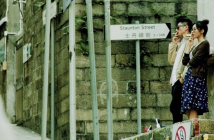
Only Image Remains (2014)
Cast: Roya Akbari, Bahram Beizai, Amir Naderi
Directors: Roya Akbari
Country: Iran | Canada
Genre: Documentary
Website: TIFF
Editor’s Notes: The following review is part of our coverage for TIFF’s I for Iran: A History of Iranian Cinema. For more information on upcoming TIFF film series visit http://tiff.net and follow TIFF on Twitter at @TIFF_NET.
Directed and narrated by Iran expatriate Roya Akbari, Only Image Remains is a wistful search for home by a woman unable to exercise her creative impulses under the tyranny of her native land. As an actress in Abbas Kiarostami’s 2002 masterpiece Ten, she was able to contribute to the demystification of a culture that is widely misunderstood and remains shrouded behind a veil of government oppression and media propaganda. Playing the role of a prostitute, she bravely subverted the prevailing cultural misogyny and through art spoke truth to power, confronting the establishment with inconvenient truths and revealing the realities of life in urban Iran to a world audience. Though her video footage in Ten was lost by the presence of a lens cap, the remaining audio was able to give a voice to the voiceless and remind us that dehumanization is a tactic that exists in a disconcerting number of government playbooks.
Only Image Remains is a wistful search for home by a woman unable to exercise her creative impulses under the tyranny of her native land.

In Only Image Remains we are shown a small portion of the rich cinematic history of a nation whose leaders have made every effort to destroy the works of its artists and intellectuals. We are presented with interviews conducted through Skype of some of Iran’s most important and influential filmmakers about who they believe were the pillars of Iranian cinema. We get impassioned interviews from Rafi Pitts on the works of Parviz Kimiavi; Amir Naderi on Sohrab Shahid Saless; and Bahram Bayzai on Arby Ovanessian and find that the progenitors of Iranian cinema are woefully undiscussed in the world’s cinematic discourse. These key filmmakers took their influences from around the world to create new dialects in the dialogue of cinema and forged a new wave of poetic neorealism that captured the mundane and elevated it to spiritual heights as they searched for the simple truths of the human condition. From Parviz Saless’ ability to craft poetry through composition, mis en scene, and sparse minimalism to Armenian immigrant Arby Ovanessian’s use of commercial techniques borrowed from American cinema as a starting point to capture the Iranian experience in the 1930s from an outsider’s perspective, we find that Iranian cinema is diverse and unique and the search for what it is to be human is universal.
Consisting largely of images from the films of Kimiavi, Saless, and Ovenessian, Only Image Remains is a poignant and heartfelt tribute to the films of a nation that would willfully erase its own cultural history. Roya Akbari watches from Toronto, heartbroken as she is powerless to change the conditions that stifle creativity and put her fellow Iranian filmmakers in danger for their defiant need to search for truths and capture them in the medium of cinema. They wait for changes that will allow for the birth of a resurgence of creativity and allow for the unmitigated expression of ideas, tied to their cinematic forefathers and unwilling to sacrifice their national identity or turn their backs to the possibility of hope as they create important art at the risk of great personal harm.
Consisting largely of images from the films of Kimiavi, Saless, and Ovenessian, Only Image Remains is a poignant and heartfelt tribute to the films of a nation that would willfully erase its own cultural history.



